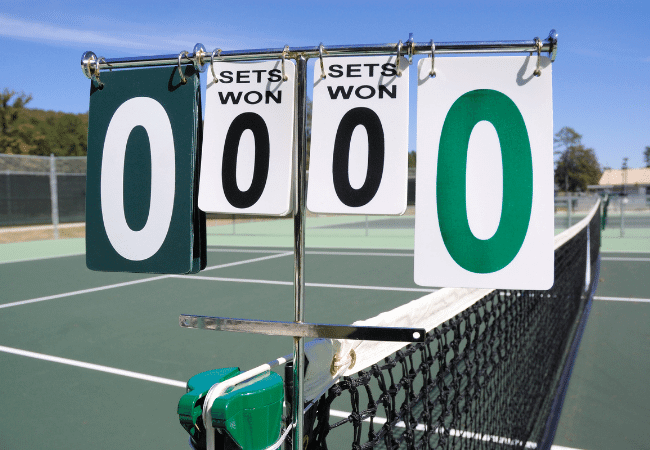Tennis and badminton are two very popular racquet sports, so it makes sense that many people wonder how they stack up to each other.
Both sports can be extremely competitive and physically demanding, or they can be played for fun in a more leisurely way. If you have ever wondered about the differences and similarities between tennis and badminton, read on!
Contents
Tennis vs. Badminton
Both tennis and badminton are played on rectangular, hard-surfaced courts, and both sports involve hitting an object over a net. While they may sound similar on the surface, these two sports are quite different.
For starters, a tennis court is much larger than a badminton court. The rackets, as well as the objects you hit with those rackets, are also very different. The net in tennis is much wider than a badminton net, but it is also quite a bit shorter.
To make things easier to understand, we will take a closer look at the details of both sports and how they compare.
Equipment Differences
Though both tennis and badminton are racket sports played on a court with specific boundaries, much of the equipment used is specialized for each specific sport.
Rackets

The main piece of equipment in either sport is the racquet, or racket. Where a tennis racket has a large head, short throat, and thick handle, a badminton racket has a relatively small head, and the handle is much longer and skinnier than that of a tennis racket.
Due to the fact that they need to be much stronger, tennis rackets weigh significantly more than badminton racquets.
A typical badminton racquet is very skinny and usually weighs about 100 grams (3.5 ounces).
A tennis racquet needs to be much thicker to withstand the force generated when the strings make contact with a heavy tennis ball. For this reason, it tends to weigh closer to 350 grams (10.6 ounces), or about 3.5 times as much as a badminton racquet.
Badminton Birdies vs. Tennis Balls
The sport of badminton involves hitting a lightweight, feathered object that is known as a birdie, or a shuttlecock. It’s designed to have an open, conical shape, which is typically formed by bird feathers or synthetic materials, like plastic.
Birdies are designed to create plenty of drag, which ensures they fly easily through the air in a consistent and predictable way. The end of the birdie has a covered cork tip, which is what actually makes contact with the strings of a badminton racquet. They typically only weigh about 5 grams (0.16 to 0.19 ounces), so they are incredibly lightweight and tend to rapidly decrease in speed shortly after they have been hit.
On the other hand, a tennis ball consists of a pressurized rubber core that is covered with a fuzzy cloth material. It tends to weigh somewhere in the range of 56-60 grams (1.98-2.1 ounces), so it’s significantly heavier than badminton birdies.
This explains why tennis racquets need to be so much sturdier than badminton racquets. In fact, if you attempted to return a tennis ball with a badminton racquet, there is a good chance that the shaft would bend or snap!
Tennis Courts vs. Badminton Courts

As mentioned, a tennis court is much larger than a badminton court. Where a tennis court is 78’ in length and 36’ in width, a badminton court is only 44’ long and 20’ wide.
Aside from the dimensions of the courts, the nets are also quite different. In both sports, the net stretches the full width of the court, but a badminton net is much taller. It stands just about 5’ high, where a tennis net is only 3’ high.
This means most badminton players loft the birdie over the net or strike it downward while it is still soaring above the net’s height. On the other hand, a tennis ball can be hit in a variety of ways and from numerous angles.
Tennis vs Badminton: Rule Differences
There are fairly substantial differences between the types of equipment and courts used for both sports. For example, it’s important to know the difference between a tennis shoe and a badminton shoe. Though there are differences, the basic rules for winning points are fairly similar.
In tennis, a point can be awarded for the following reasons:
• The ball fails to land within the boundaries of the opponent’s side of the court on the first bounce. The player receiving the ball would win a point.
• The ball double bounces on one side of the court before it is returned. The player that caused the ball to double bounce would win a point. A point would also be scored if the player managed to bounce the ball in the opponent’s court, but then it bounced beyond the boundaries without being returned.
• A point is awarded as a result of faulting (a player touches the net with their body or racquet, or a player serves a double fault, meaning they make a mistake on both serving opportunities).
In badminton, a point can be won when:
• The birdie fails to land within the opponent’s boundaries, the player that was receiving the birdie would score a point. This can occur when the birdie is blocked by the net, if it lands on the same side of the court that it was hit from, or if it lands out of bounds on the other side of the court.
• The birdie lands within the boundaries of the opponent’s side of the court without being returned, the player that made the shot would win a point.
• A fault is called, which is almost identical to the fault rules for tennis.
Tennis vs Badminton: Scoring Points

Where points are won in a relatively similar manner, the scoring system is actually quite different.
In badminton, each game ends when a player reaches 21 points, but they must win by two. From there, the match is decided with a best-of-three matchup, meaning one player must win two games to win the match.
Points can also be scored by any player, regardless of which side is serving.
In tennis, the scoring system is a little bit more complex. To win a match, one side must win two out of three sets (other than men’s matches in a grand slam tournament), where each set is composed of games. A set is won when one side wins six games, but they must also win by at least two games.
Each game starts at “love,” which basically means zero. From there, the score goes up to 40, which is actually just four points. The scoring progresses from love to 15, 30, then 40, with the winner needing to score at least two points more than their opponent. If the score is tied at 40, the game continues. Winning by one point from this tied position is referred to as “advantage.” If that same player scored another point, they would win, otherwise the game would continue until one player won two points in a row.
For more information on tennis scoring, check out this post.
Gameplay Differences
The differences between the dimensions of the courts, height of the nets, and properties of the objects hit mean that the two sports are played in very different ways.
Then there is the fact that a badminton birdie must not touch the ground, where a tennis ball is allowed to bounce before it is hit.
Due to the airy and lightweight character of a badminton birdie, shots tend to be lifted and smashed, rather than volleyed over the net. This changes the way players need to maneuver around the court.
Since a tennis court is much larger than a badminton court, tennis players tend to rely more on speed, positioning, and agility to win matches. Badminton places a greater emphasis on jumping and lunging toward the birdie, with far less running and fewer lateral movements. (That is outside of the Olympics. The Olympic competitors zoom all over the court!)
Should Tennis Players Try Badminton?
If you are wondering if play badminton will make you a better tennis player, ask yourself if you would enjoy playing badminton.
Playing badminton might help you improve your hand-eye coordination and reaction time, but it likely won’t directly correlate to your tennis skills.
There are few transferable skills between badminton and tennis. A birdie reacts very differently than a tennis ball, so the sport is played in a distinct way.
With that being said, badminton is an incredibly fun to play. It could be worth playing just for your own entertainment and to enjoy a new challenge.
Badminton does require a fair amount of forearm strength, so playing could potentially help you improve your grip.
Overall, you should view badminton like a cousin sport of tennis. The two activities share similarities as racket sports, but remain quite different. For information on how tennis stacks up to pickleball, check out this post!


